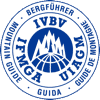Easy: No prior rock climbing, glacier travel or ice climbing experience required
Moderate: Rock climbing in exposed 4th class or easy fifth class terrain in mountaineering boots, glacier travel in crevassed terrain
Difficult: Rock climbing in exposed 4th class up to mid fifth class terrain in mountaineering boots. The route could involve substantial time on the front points of the crampons with some moderately steep ice climbing. Some of the movement can be on rock with crampons on in exposed terrain. Some previous ice climbing experience recommended.
Very difficult: Rock climbing in exposed 4th class up to 5.8 class terrain in mountaineering boots. The route could involve substantial time on the front points of the crampons with some steep ice climbing. Some of the movement can be on rock with crampons on in exposed terrain. Prior ice climbing experience highly recommended.

